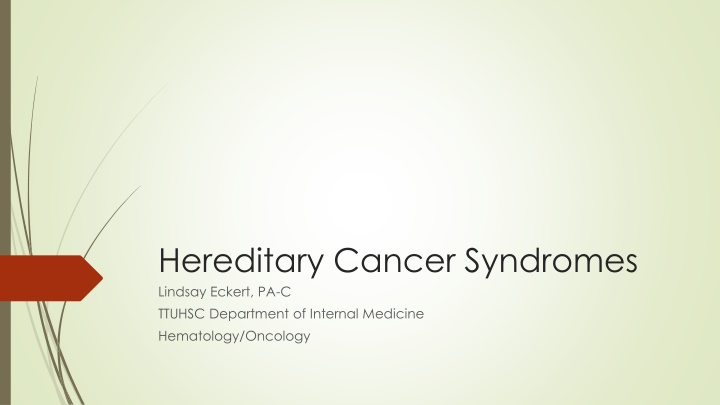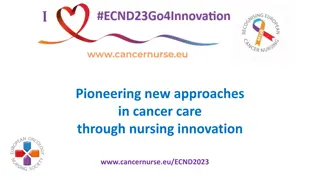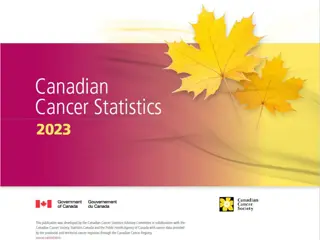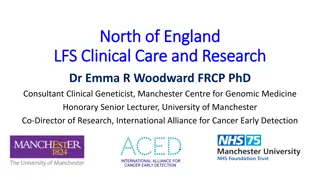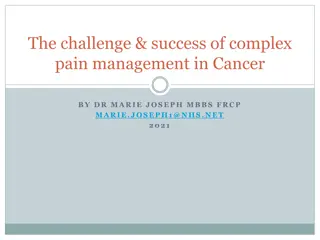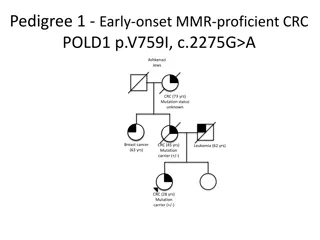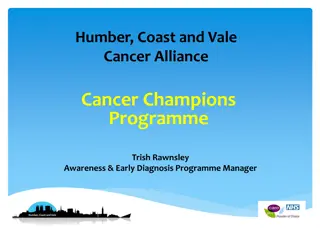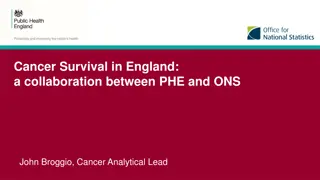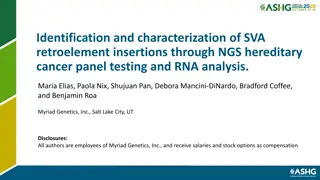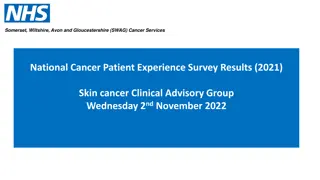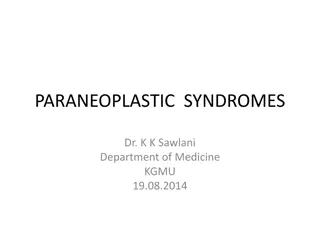Hereditary Cancer Syndromes
Explore the nuances of genetic testing, implications of hereditary cancer syndromes, and strategies for managing patients with genetic mutations. Learn the differences between somatic and germline mutations, interpreting test results, and the importance of identifying at-risk patients. Discover the significance of BRCA1 mutations in various cancers and the value of multi-gene panels in testing strategies.
Download Presentation

Please find below an Image/Link to download the presentation.
The content on the website is provided AS IS for your information and personal use only. It may not be sold, licensed, or shared on other websites without obtaining consent from the author.If you encounter any issues during the download, it is possible that the publisher has removed the file from their server.
You are allowed to download the files provided on this website for personal or commercial use, subject to the condition that they are used lawfully. All files are the property of their respective owners.
The content on the website is provided AS IS for your information and personal use only. It may not be sold, licensed, or shared on other websites without obtaining consent from the author.
E N D
Presentation Transcript
Hereditary Cancer Syndromes Lindsay Eckert, PA-C TTUHSC Department of Internal Medicine Hematology/Oncology
Objectives To understand the difference between a somatic and germline mutation To review testing available To understand the limitations and meaning of a negative genetic test To identify which patients are at risk for a hereditary cancer syndrome and should undergo genetic testing To manage patients with various genetic mutations and hereditary cancer syndromes
Why Should we do Genetic Testing About 5-10% of cancer is hereditary Treatment implications (PARP inhibitors) Risk of other cancers Family risk
Somatic vs. Germline Mutations May be paired together Somatic (tumor) testing Predicts response or resistance to drug therapy Helps determine favorable/unfavorable prognosis Can be diagnostic of cancer type Can potentially show germline mutations Germline testing Helps determine risk for cancer predisposition Predicts response or resistance to drug therapy (PARP inhibitors) Will impact both patients and their families
What Type of Test Should I Order: Multi-gene Panel vs. Single Site Testing No established guidelines exist for when a multi-gene panel vs. single site testing should be ordered Consider multi-gene panel when 1 or more syndromes may explain the family history or if young age of cancer diagnosis Stepwise testing may present a higher cost to the patient (additional testing, multiple clinic visits) Lack of knowledge of family history
Interpretation of Test Results Positive Negative VUS
BRCA1 BRCA1 increases the risk of female breast cancer (>60%), male breast cancer (1.2%), ovarian cancer (39-58%), prostate cancer (7-26%) and pancreatic cancer (<5%). BRCA1 mutations make up about 50% of hereditary breast cancers and about 70% of hereditary ovarian cancers More BRCA1 mutations in triple negative breast cancers
BRCA2 BRCA2 increases the risk of female breast cancer (>60%), male breast cancer (7.1%), ovarian cancer (13-29%), prostate cancer (19-61%), pancreatic cancer (5-10%) and melanoma. BRCA2 mutations make up about 30% of hereditary breast cancers and about 20% of hereditary ovarian cancers BRCA2 mutations are more associated with DCIS than BRCA1 mutations
Hereditary Breast and Ovarian Cancer Syndrome (HBOC) BRCA 1/2
Hereditary Breast and Ovarian Cancer Syndrome (HBOC) BRCA 1/2
Hereditary Breast and Ovarian Cancer Syndrome (HBOC) BRCA 1/2
HBOC Management Female breast cancer Self breast exams beginning at age 18 and clinical breast exam every 6-12 months beginning at age 25 Annual breast MRI beginning at age 25 and mammogram beginning at age 30 or 10 years younger than earliest breast cancer diagnosis in the family Discuss option of risk reducing mastectomies (RRM) Chemoprevention with tamoxifen Male breast cancer screening with self-exam and annual clinical exam at 35 Ovarian cancer Recommend risk reducing Salpingo-Oophorectomy (RRSO) between 35 and 40 after completion of childbearing Consider ovarian suppression for delayed surgery and annual transvaginal u/s with CA-125 monitoring Pancreatic cancer Consider screening with annual abdominal MRI/MRCP and EUS beginning at age 50 or 10 years prior to earliest diagnosis in the family Prostate cancer screening with PSA every 1-2 years if <3 beginning at age 40 and consideration of DRE Melanoma screening with annual dermatology visits and risk management discussion
Hereditary Nonpolyposis Colon Cancer (HNPCC) Lynch Syndrome MLH1, MSH2/EPCAM, MSH6, PMS2 The most common hereditary colorectal cancer syndrome Estimated to occur in over 1.2 million individuals in the US (1 in 279). Increases the risk of colorectal, endometrial, ovarian, gastric, urinary tract, small bowel, bile duct cancers and sebaceous skin tumors Limited evidence of association with breast cancer (absolute risk <15) Accounts for 1 out of every 25 (4%) colorectal cancers with a mean age of diagnosis at 45 Accounts for 1 out of every 30 (3%) endometrial cancers Individuals with a personal or family history of Tumor screening with immunohistochemistry (IHC) and microsatellite instability (MSI) should strongly be considered on colorectal and endometrial tissue (recommended by CDC, NCCN).
Lynch Syndrome Management Colorectal cancer risk (46-61%) High quality colonoscopy every 1-2 years beginning at age 20-25 years Use of daily aspirin to reduce future risk of CRC Endometrial cancer risk (34-57%) Patients should be educated about abnormal uterine bleeding or postmenopausal bleeding Consideration of endometrial biopsy every 1-2 years starting at age 30 Consideration of risk reducing hysterectomy after childbearing Ovarian cancer risk (4-38%) Consideration of RRSO after childbearing Consider ovarian suppression for delayed surgery and annual transvaginal u/s with CA-125 monitoring Urothelial cancer risk (0.2-28%) No clear evidence for surveillance but may consider annual urinalysis beginning at age 30
Lynch Syndrome Management Cont. Gastric and Small bowel cancer risk (0.4-11%) Upper GI with EGD every 2-4 years beginning at age 30 Pancreatic cancer risk is 5-10% (insufficient evidence for pancreatic cancer screening with PMS2) Consider screening with annual abdominal MRI/MRCP and EUS beginning at age 50 or 10 years prior to earliest diagnosis in the family Prostate cancer risk(4.4-23.8%) Consider screening with PSA every 1-2 years beginning at age 40 and consideration of DRE Breast cancer risk: Annual mammograms beginning at age 40 or 10 years prior to earliest diagnosis in the family Brain (0.7-7.7%): Patients should be educated regarding signs/symptoms of neurologic cancer and prompt reporting of symptoms Skin: Consider skin exam every 1-2 years with dermatology due to risk of both malignant and benign skin tumors
Muri-Torre Syndrome A subtype of Lynch syndrome Sebaceous neoplasms in combination with one or more visceral malignancies Sebaceous hyperplasia Sebaceous adenoma Sebaceous epithelioma Basal cell epithelioma with sebaceous differentiation Keratoacanthoma Sebaceous carcinomas
Familial/Attenuated Adenomatous Polyposis (FAP/AFAP) APC Increases the risk of colorectal, gastric, duodenal and thyroid cancers, desmoid tumors (approximately 10-20% of patients with FAP), hepatoblastoma and brain tumors Testing is recommended for a personal history of 20 or more cumulative adenomas, known APC mutation in the family or multifocal/bilateral congenital hypertrophy of the retinal pigment epithelium (CHRPE) Testing should be considered for a personal history of 10-19 cumulative adenomas, desmoid tumor, hepatoblastoma, cribiform-morular variant of papillary thyroid cancer, unilateral CHRPE, family history of polyposis and family is unwilling or unable to undergo testing
Classical FAP Up to 30% of cases are due to de novo mutations (spontaneous mutation in the patient s germ cell) 100s-1000s of polyps with about 50% of carriers having adenomas by age 14 and 90% by age 30. Untreated polyposis leads to 100% risk of cancer Mean age of colorectal cancer (CRC) diagnosis at age 39 and mean age of death from CRC at age 42. Extraintestinal features epidermoid cysts, osteoma, supernumerary teeth and adrenal gland adenomas.
AFAP <100 polyps with and increased frequency of right-sided distribution Colon cancer risk approaches 705 for untreated polyposis Later onset than FAP with mean age of 50 for CRC Extraintestinal manifestations not as common as with classical FAP
FAP Management High quality colonoscopy annually beginning between ages 10-15 years Prophylactic surgery (proctocolectomy or total colectomy) Post-op still needs screening Upper endoscopy beginning at age 20-25 years Evidence for small bowel screening is lacking but may be considered Baseline thyroid u/s in late teenage years, then every 2-5 years if normal Abdominal symptoms should prompt immediate abdominal imaging with CT or MRI due to risk of intra-abdominal desmoids Consideration of abdominal u/s and AFP every 3-6 months for the first 5 years of life due to hepatoblastoma risk Chemoprevention with Aspirin
MUTYH Associated Polyposis (MAP) (MUTYH) Autosomal recessive inheritance pattern (must inherit one mutation from each parent) Increases the risk of colorectal and duodenal polyps and cancer Typically fewer than 100 adenomas with 70-90% of colon cancer if left untreated High-quality colonoscopy every 1-2 years beginning no later than 25-30 years Consider colectomy or proctocolectomy if dense polyps Baseline upper endoscopy beginning at age 30-35 years No increased screening for monoallelic carriers without a family history
Hereditary Diffuse Gastric Cancer (HDGC) CDH1 An autosomal dominant syndrome characterized by the development of diffuse (signet ring cell) gastric cancers at a young age. Increases the risk of gastric and breast cancers (mostly lobular) Causes 1-3% of gastric cancers with an estimated risk of gastric cancer of 67% for men and 83% for women by age 80. Average age of diagnosis of gastric cancer is 37. Lobular breast cancer observed in 20-40% of female carriers
HDCG Testing Criteria Genetic testing for CDH1 mutations should be considered when any of the following criteria are met: Two gastric cancer cases in a family, one confirmed diffuse gastric cancer regardless of age Diffuse gastric cancer diagnosed before age 50 without a family history Personal or family history of diffuse gastric cancer and lobular breast cancer, one diagnosed before age 70 Two cases of lobular breast cancer in family members before age 50 Bilateral lobular breast cancer before age 70
HDGC Management Breast cancer screening with annual mammogram and consideration of breast MRI beginning at age 30 with consideration of RRM Prophylactic total gastrectomy is recommended between ages 18 and 40 but may be considered earlier based on family history CDH1 mutation carriers who elect not to undergo prophylactic gastrectomy, should be offered screening every 6 12 months by upper endoscopy with multiple random biopsies. Unfortunately, the diffuse type of stomach cancer in difficult to diagnose because the cancer is not visible on upper endoscopy and many cancers are diagnosed at late stages.
Li-Fraumeni syndrome (LFS) TP53 High Penetrance mutation Young age at first diagnosis (<20 years) with continuing risk of new tumors throughout lifespan. Increased risk of breast cancer in females, brain tumors, leukemia, adrenocortical carcinoma ( signature cancer for Li-Fraumeni), and sarcoma.
LFS Management Breast cancer risk: >60% Annual breast MRI beginning at age 20 and annual mammogram at age 30 Consideration of RRM Other cancer risks Comprehensive physical exam including neurologic examination Colonoscopy and upper endoscopy every 2-5 years starting at age 25 Annual dermatologic exam beginning at age 18 Annual whole body MRI Annual brain MRI Annual PSA beginning at age 40
CHEK2 Breast cancer risk: 20-40% Annual mammogram at age 40 and consider breast MRI beginning at age 30-35 Insufficient evidence to recommend RRM; manage based on family history Colorectal cancer risk: 5-10% Colonoscopy every 5 years beginning at age 40 Prostate cancer risk is emerging Consider screening with PSA beginning at age 40
ATM Breast cancer risk: 20-30% Annual mammogram at age 40 and consider breast MRI beginning at age 30-35 Insufficient evidence to recommend RRM; manage based on family history Ovarian cancer risk: 2-3% Insufficient evidence to recommend RRSO; manage based on family history Pancreatic cancer risk: 5-10% Screen carriers with a family history of pancreatic cancer Prostate cancer risk is emerging Consider screening beginning at age 40
Cowden Syndrome PTEN Macrocephaly, acral keratosis, oral mucosa cobblestoning, breast, uterine, thyroid and kidney cancers, autism spectrum disorder Breast cancer risk: 40-60% Annual mammogram and breast MRI beginning at age 30 or 10 years prior to earliest known breast cancer in the family Discuss option of RRM based on family history Colorectal cancer Colonoscopy starting at age 35 or 10 years prior to earliest known CTC in family and repeat every 5 years or more frequent if polyps or symptoms Uterine cancer Screening beginning at age 35 via endometrial biopsy every 1-2 years Transvaginal u/s has not been shown to be sensitive or specific but may be considered Discussion of hysterectomy upon completion of childbearing Kidney cancer: consider renal u/s every 1-2 years beginning at age 40 Thyroid cancer: annual u/s beginning at age 7
Peutz-Jeghers Syndrome (PJS) STK11 Increased risk of GI, breast, thyroid, lung, pancreatic, uterine, ovarian sex cord tumors and Sertoli cell testicular tumors. Causes hyperpigmented macules on buccal mucosa and lips Associated with hamartomatous polyps
PJS Diagnosis A clinical diagnosis of PJS can be made when an individual has two or more of the following features: Two or more Peutz-Jeghers-type hamartomatous polyps of the GI tract Mucocutaneous hyperpigmentation of the mouth, lips, nose, eyes, genitalia, or fingers Family history of PJS Clinical genetic testing is recommended for any patient meeting the above criteria or with a family history of PJS. The majority of cases occur due to pathogenic variants in the STK11 gene.
Peutz-Jeghers Management Colon/Gastric cancer risk: 39-29% Upper endoscopy and colonoscopy beginning at age 8-10. If no polyps, resume at 18 every 2-3 years. If polyps, repeat every 2-3 years. Breast cancer risk: 32-54% Annual mammogram and breast MRI beginning at age 30 Discuss option of RRM Pancreatic cancer risk: >15% Annual imaging of the pancreas with EUS or MRI/MRCP beginning in early 30s Annual testicular exam beginning at age 10. Non-Epithelial Ovarian cancer: >10% Annual pelvic exam and u/s beginning at age 1-20 years
Multiple Endocrine Neoplasia (MEN) MEN1 Pituitary adenoma (20%) Hyperparathyroid (95%) pNET (20-80%) Duodenal gastrinoma (up to 25% of gastrinomas are MEN1 positive)
MEN2 RET Type 2A Hyperparathyroidism (~25%) Medullary thyroid cancer (~90%) Pheochromocytoma (~50%) Type 2B Marfanoid habitus Mucosal neuromas Medullary thyroid cancer (near 100%) Pheochromocytoma (~50%) Elective thyroidectomy age 1 for MEN2B and 5 or older for MEN2A Annual calcium and metanephrine levels
Other Notable Symdromes Von Hippel Lindau (VHL) - Increased risk of renal cell carcinoma, retinal angioma, cerebellar hemangioblastoma, pheochromocytoma, pancreatic cysts/pNETs, islet cell tumors and epididymal cystadenoma Birt-Hogg-Dube (FLCN) - Increases the risk of renal cancer and cysts, pulmonary cysts and noncancerous tumors (thyroid nodules) Familial melanoma (CDKN2A) - Increases the risk of melanoma (28-76% depending on other risk factors) and pancreatic cancer (>15%) Hereditary leiomyomatosis and renal cell (FH) renal cancer, leiomyomas, adrenal hyperplasia Hereditary papillary renal cell SDHx-related hereditary paraganglioma syndrome (SDHA, SDHB, SDHC, SDHD, SDHAF2) paragangliomas, renal cell carcinoma, pituitary tumors, GIST Juvenile polyposis (BMPR1A or SMAD4) colon, gastric, small bowel and pancreas Serrated polyposis (RNF43 soft linkage)
Pediatric Cancer Syndromes Retinoblastoma (RB1) Wilms tumor (WT1) Rhabdoid predisposition syndrome (SMARCB1, SMARCA4) Nevoid basal cell carcinoma syndrome, medulloblastoma (PTCH) Neurofibromatosis (NF1) Familial neuroblastoma (ALK, PHOX2B, RET) Tuberous sclerosis (TSC1, TSC2)
References City of Hope Division of Clinical Cancer Genomics Duarte, Caliornia Intensive Course in Genomic Cancer Risk Assessment November 9, 2018 March 14, 2019. Edaily, Sarah and Hikmat Abdel-Razeq. Management Strategies of Breast Cancer Patients with BRCA1 and BRCA2 Pathogenic Germline Variants." Dovepress July 27, 2022 Fauci et al. Harrison s Principles of Internal Medicine, 17thedition Hereditary Diffuse Gastric Cancer (HDGC)." Johns Hopkins. www.hopkinsmedicine.org/health/conditions-and- diseases/hereditary-diffuse-gastric-cancer-hdgc Kohlmnn W, Gruber SB. Lynch Syndrome." 2004 Feb 5 [Updated 2014 May 22]. In: Pagon RA, Adam MP, Ardinger HH, et al., editors. Gene Reviews. Seattle (WA): University of Washington, Seattle; 1993-2014 Le DT et al. PD-1 Blockade in Tumors with Mismatch-Repair Deficiency." New England Journal of Medicine 2015; 372 (26): 2509-20. Massari G et al. Frequency of CDH1 Germline Mutation in Non-Gastric Cancers." Cancers 2021 May 13(10) 2321 "NCCN Guidelines Genetic/Familial High-Risk Assessment: Breast, Ovarian and Pancreatic." NCCN.org, version 2.2024, National Comprehensive Cancer Network, www.nccn.org/professionals/physician_gls/pdf/genetics_bop.pdf "NCCN Guidelines Genetic/Familial High-Risk Assessment: Colorectal." NCCN.org, version 1.2023, National Comprehensive Cancer Network, www.nccn.org/professionals/physician_gls/pdf/genetics_colon.pdf Vasen HFA et al. Guidelines for the Clinical Management of Lynch Syndrome (Hereditary Non-polyposis Cancer)." Journal of Medical Genetics 2007 Jun; 44(6): 353-362
